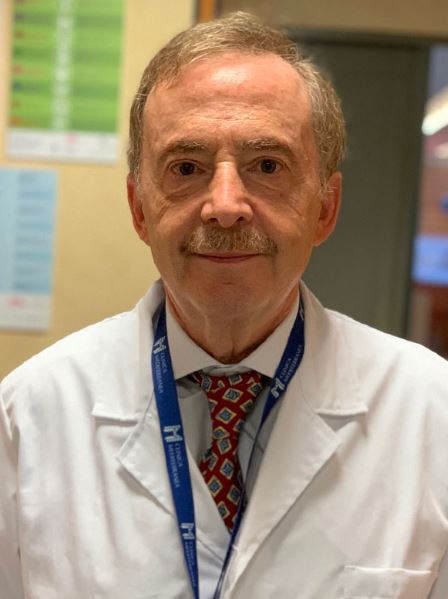
In South Korea, starting August of last year, patients with acute myocardial infarction who undergo autologous peripheral blood stem cell therapy at Seoul National University Hospital became eligible for temporary health insurance coverage until October 2024. This is the first case of applying health insurance to innovative medical technology in a situation in which the efficacy of stem cells is attracting attention again concerning heart disease. I had an interview with Eugenio Caradonna, the President of the Italian Society of Regenerative Medicine, who is dedicated to researching regenerative medicine in cardiac surgery.
Caradona, the president of the Association, is a cardiothoracic surgeon researching heart disease since 1974. He has published more than 110 papers in academic journals and has given lectures internationally.
- What kind of research is the Italian Association for Regenerative Medicine mainly doing?
We deal with regenerative medicine with all specialized fields encompassing and analyzing biological information, such as stem cells. The Italian Association for Regenerative Medicine pays particular attention to stem cell research,
biotechnology, and biomaterials research, leading to regenerative medicine in the surgical fields.
- You have been a cardiothoracic surgeon for a long time. How do you use autologous stem cells in the field?
Restoring cardiac function utilizing stem cells is challenging to treat angina pectoris. It shows promise regarding treatments for cardiomyopathy and heart failure, but the current usage is unsure and not entirely determined.
One example is the transplantation of bone marrow stem cells into the coronary arteries or the myocardium, which has shown some positive effects in chronic ischemic heart disease. This has been interpreted to be associated with the number of transplanted cells.
However, consistent clinical research focusing on optimal bone marrow harvesting methods, cell dosage, and transplantation techniques is still needed. Furthermore, more active research is required on the use of induced pluripotent stem cells (iPSCs), embryonic stem cells (ESCs), cardiac stem cells (CSCs), and skeletal muscle cells.
- What autologous stem cells are most commonly used in cardiac surgery?
The most common type of stem cell used in heart surgery is derived from bone marrow. Autologous bone marrow stem cells are considered a key component in the natural healing of the heart following myocardial infarction, commonly referred to as the bone marrow-cardiac axis.
- How is 'autologous platelet-rich plasma (PRP) therapy' applied in cardiac surgery?
The use of PRP in heart surgery is essential.
There are several cases where PRP should be used extensively.
One of the prominent cases is the occurrence of sternotomy complications, such as wound dehiscence and infections, in 0.2% to 8% of cardiac surgery patients following the median sternotomy (a surgical incision in the middle of the chest). Using PRP therapy in such cases can be expected to reduce the incidence of sternotomy complications after cardiac surgery and potentially lead to cost savings.
Therefore, PRP therapy is recommended for all patients, including seniors, those with diabetes, and those undergoing bilateral internal mammary artery harvesting or sternotomy for cardiac surgery, who are at a high risk of developing wound complications.
According to recent research, combining cells with growth factors derived from PRP, either in isolation or within a biomaterial, has been evaluated as a breakthrough in treating myocardial infarction.
- PRP therapy is indeed considered a form of autologous stem cell therapy. However, there have been criticisms from some quarters regarding the generalization of PRP therapy due to the limited available data on its efficacy and safety.
PRP is obtained by collecting the patient's blood.The results of PRP therapy can vary depending on the method used to extract and concentrate the platelets, typically done through a two-step centrifugation process. Different extraction techniques can lead to different outcomes in the treatment.
PRP treatment, which is well-concentrated in a germ-free state, has been confirmed to be effective in many diseases today. The use of well-concentrated PRP therapy, free from pathogens, has become a proven treatment method for various conditions today. It is increasing in usage in many fields.
PRP therapy is used in various fields, such as dentistry, dermatology, plastic surgery, and orthopedics, and the number of clinical applications continues to grow. In particular, in the case of knee osteoarthritis, it has been proven to be more effective than hyaluronic acid.
However, in cardiac surgery, PRP therapy is not recommended for patients with a platelet count below 100,000/μL, platelet disorders, cancer, or autoimmune diseases.
- I heard that the choice of PRP kits used could influence the quality and effectiveness of PRP therapy.
For the extraction of PRP, it is crucial to use kits that prevent bacteria entry and facilitate platelet separation and concentration.
One example is the Tricell PRP kit produced by Rev-Med in Korea, which allows for both steps of centrifugation to be conducted in a single kit. This offers the advantage of enhanced safety compared to other kits, as it ensures the integrity of the process.
- The advantage of PRP therapy lies in its use of autologous cells, which results in minimal side effects. As a result, the potential for its application is extensive. What are the prospects for PRP therapy?
PRP therapy is experiencing a continuous expansion in the field of cardiac surgery. Furthermore, it has already been applied in cases of avascular necrosis of the femoral head.
As a result, PRP therapy is expected to continue expanding, particularly in orthopedic surgery, where research on osteoarthritis is actively being pursued.


